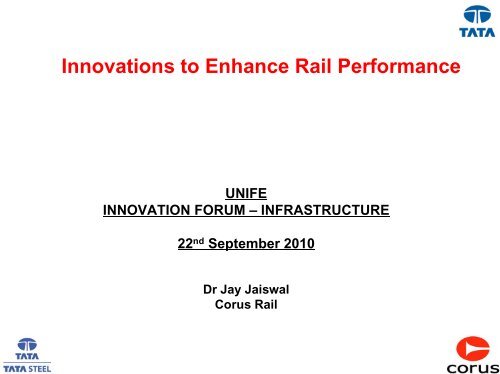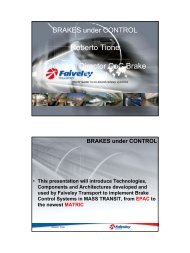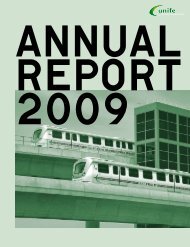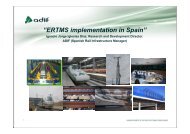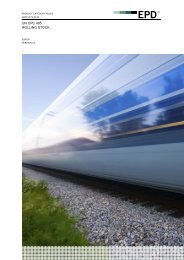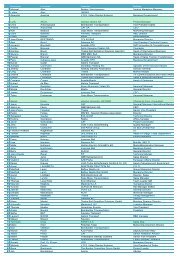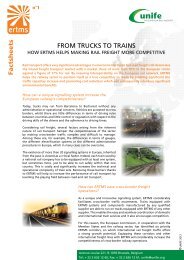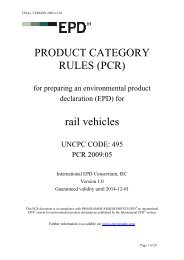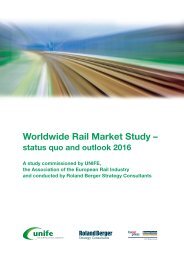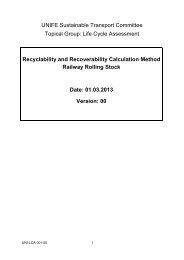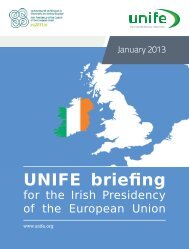Innovations to Enhance Rail Performance - Unife
Innovations to Enhance Rail Performance - Unife
Innovations to Enhance Rail Performance - Unife
You also want an ePaper? Increase the reach of your titles
YUMPU automatically turns print PDFs into web optimized ePapers that Google loves.
<strong>Innovations</strong> <strong>to</strong> <strong>Enhance</strong> <strong>Rail</strong> <strong>Performance</strong><br />
UNIFE<br />
INNOVATION FORUM – INFRASTRUCTURE<br />
22 nd September 2010<br />
Dr Jay Jaiswal<br />
Corus <strong>Rail</strong>
Past & Present <strong>Rail</strong> Microstructures<br />
1767 Cast Iron ~ 3%C; 200HB<br />
1808 Wrought Iron 0.05%C; 174HB<br />
1857 Bessemer Steel ~ 0.25%C; 182HB<br />
100µm<br />
1950 BS11 Normal (R220);<br />
~0.55%C, 230HB<br />
1970 Grade A (R260) 1985 MHT (R350HT)<br />
280HB<br />
350HB<br />
Steel ~ 0.8%C<br />
Current HE Grades (R400HT)<br />
>400HB Steel ~ 0.9%C<br />
2
Past & Present <strong>Rail</strong> Microstructures<br />
Key Aspects of <strong>Rail</strong> Developments Over last 200 years<br />
• Increasing Steel Cleanness<br />
• Increasing Weight of <strong>Rail</strong> Sections<br />
Reduce Defects<br />
• Increasing Carbon Content<br />
• Increasing Hardness<br />
Reduce Wear<br />
• Longer lengths<br />
– 120m hot rolled<br />
– Several hundred m welded lengths<br />
Reduce Joints/Welds<br />
• The achievement of 2020/2030 transport visions demands more<br />
innovations<br />
3
<strong>Innovations</strong> from Corus<br />
• Corus has an outstanding record in bringing innovations in<strong>to</strong> the industry – the key recent<br />
innovations reducing LCC of track infrastructure<br />
– Distinctive rail grades <strong>to</strong> combat key degradation mechanisms<br />
– RAILCOTE - Coated rails <strong>to</strong> combat corrosion prone environments<br />
– Semi-au<strong>to</strong>matic weld res<strong>to</strong>ration of discrete rail head defects<br />
– Steel - Concrete Two Layer <strong>Rail</strong>way Track - consistently supported S&C track form<br />
4
Addressing <strong>Rail</strong> Degradation<br />
• Traditionally, selection of rail grades has been governed by the track<br />
radius and the annual <strong>to</strong>nnage carried<br />
• However, the introduction of various vehicle types and variations in<br />
track support conditions indicate that the behaviour in curves with<br />
similar radius & <strong>to</strong>nnage can be significantly different<br />
• Hence, one of the rail grade selection criteria developed within the<br />
Innotrack Project is based on observed degradation mechanism<br />
5
Innovative <strong>Rail</strong> Steel Grades – Corus MHH<br />
10 mm<br />
25 mm<br />
x8000<br />
• Corus 400 MHH (R370CrHT) is a well proven product with >300kt installed in major railways of<br />
the world. The distinctive features compared <strong>to</strong> in-line heat treated rails are:<br />
– Finer grain size from the controlled low temperature reheating, imparting <strong>to</strong>ughness<br />
– Finer pearlitic microstructure from the controlled cooling imparting high hardness <strong>to</strong> greater depths<br />
– Much lower residual stresses in both the head and foot, imparting greater resistance <strong>to</strong> defects<br />
• Corus 400 MHH grade is ideal for locations demanding greatest resistance <strong>to</strong> wear<br />
Conditions<br />
Longitudinal stresses (MPa) Saw cut test<br />
Head Web Foot (mm)<br />
Natural cooling before straightening +30 -20 +30 +0.2<br />
Natural cooling after standard straightening +180 -160 +220 +1.8<br />
Natural cooling after optimised straightening +140 -110 +190 +1.5<br />
Off line heat treatment without straightening -86 +41 -30 -1.5<br />
6
Innovative <strong>Rail</strong> Steel Grades - Corus Bainitic <strong>Rail</strong><br />
Grade B320 Grade B360 Grade B440<br />
• Corus B320 has been installed in Eurotunnel (4200m radius)<br />
• <strong>Performance</strong> AFTER >250 MGT<br />
R260 – Visible RCF Present<br />
Corus B320 – Virtually No RCF Present<br />
Increasing Hardness of Bainitic Grades<br />
• Bainitic <strong>Rail</strong> Steels<br />
• Conventional bainitic structure – Ferrite and Carbide<br />
• Have been tried in the past but offered no real advantages<br />
• Low-carbon carbide free structure – Ferrite and Austenite<br />
• Control of composition & residual stress <strong>to</strong> eliminate risks from susceptibility <strong>to</strong><br />
Stress Corrosion Cracking<br />
• Good performance in track tests in SNCF (B320), SBB (B360), Eurotunnel (B320)<br />
7
Latest Innovation in <strong>Rail</strong> Steel<br />
Corus “High <strong>Performance</strong>” (HP) <strong>Rail</strong><br />
• Corus “High <strong>Performance</strong>” (HP) <strong>Rail</strong><br />
• Metallurgically Engineered Pearlitic <strong>Rail</strong> Steel<br />
• Increased volume fraction of pearlitic cementite<br />
• Increased strength of pearlitic ferrite<br />
8
Corus HP Steel – Test results<br />
240,000<br />
Current Pearlitic Steels Corus HP Lab Cast Corus HP BOS Cast<br />
200<br />
Number of Cycles <strong>to</strong> RCF Initiation<br />
200,000<br />
160,000<br />
120,000<br />
80,000<br />
40,000<br />
0<br />
200 250 300 350 400 450<br />
Steel Hardness, HB<br />
Wear Rate (mg/m of slip)<br />
160<br />
120<br />
80<br />
40<br />
0<br />
200 250 300 350 400 450<br />
Hardness (HB)<br />
Current Pearlitic Steels<br />
Corus HP Steels<br />
• The traditional reliance on hardness for increased resistance <strong>to</strong> wear<br />
and rolling contact fatigue has been successfully challenged through<br />
judicious engineering of the pearlitic microstructure. HP steel offers:<br />
–A STEP CHANGE improvement in resistance <strong>to</strong> rolling contact fatigue<br />
– Increased wear resistance at lower levels of hardness<br />
9
Protecting Against <strong>Rail</strong> Corrosion<br />
• <strong>Rail</strong> life is severely curtailed in locations such as level crossings, coastal lines, wet<br />
tunnels, and stray current environments<br />
• Traditionally a range of epoxy/polyester barrier coatings have been employed<br />
– Limited success because of the damage caused by harsh rail handling<br />
• Corus RAILCOTE is high purity zinc coating that has provided the best results<br />
• Several test sites in Network <strong>Rail</strong> & RATP have already provided appreciable<br />
increase in rail life<br />
10
The Innovative Discrete Defect Repair Process<br />
• Complex Contact Conditions: even the best maintained railway networks develop<br />
discrete defects –<br />
– wheel burns, squats, Belgrospies …<br />
• Network <strong>Rail</strong> Assessment: ~10,000 squats/wheel burns removed annually - ~6000 weld<br />
repairable<br />
– Average cost of replacement estimated at ~£2.5k per defect or ~£15 million annual<br />
expenditure<br />
• Application in<strong>to</strong> the wider <strong>Rail</strong>way World provides a very strong case for innovation of a<br />
repair procedure<br />
• Corus Discrete Defect Repair procedure has successfully met the Innovation challenge<br />
11
The Innovative Discrete Defect Repair Process<br />
• Milling:<br />
– Rapid excavation of defects <strong>to</strong> prescribed dimensions for consistency of quality<br />
• Weld Repair:<br />
– Innovation lies in the avoidance of preheating <strong>to</strong> the conventional temperature of 350 0 C<br />
– Semi- au<strong>to</strong>matic Open Arc Welding employing Flux Cored Arc Wire and controlled patterned<br />
weave and energy input<br />
• Grinding<br />
– Rough milling followed by manual grinding <strong>to</strong> blend rail profiles<br />
• The RESULT<br />
– A COST EFFECTIVE & ROBUST weld repair with an extremely HIGH FATIGUE STRENGTH<br />
– AVOIDS new AT WELDS or the need for RE-STRESSING<br />
– A CONSISTENT & RAPID process <strong>to</strong> minimise loss of track availability<br />
12
Key Attributes Achieved<br />
• CONSISTENT SUPPORT – Separate strong steel frame with high longitudinal stiffness<br />
• MODULAR CONSTRUCTION – train load taken before base is ready<br />
• REDUCED TRAFFIC DISRUPTION - Designed <strong>to</strong> open <strong>to</strong> line speed at handovers<br />
• NO MAJOR CIVILS WORK - Two layer design with adjustment capability<br />
• MINIMUM MAINTENANCE – Restricted <strong>to</strong> grinding & rail replacement through wear<br />
• LOW FIRST COSTS - Installation costs comparable <strong>to</strong> conventional ballasted<br />
installations provided time delay penalties are also accounted for.<br />
13
Conclusions<br />
• Corus remains committed <strong>to</strong> directing its diverse metallurgical &<br />
engineering expertise <strong>to</strong> develop innovative products & processes<br />
for the rail transport sec<strong>to</strong>r<br />
– Novel rail steels offer opportunities for significant reductions in LCC<br />
– The novel Discrete Defect Repair procedure offers a much more<br />
robust & cost effective process for repairing defects such as squats &<br />
wheel burns<br />
– A novel 2-layer track form offers a near “maintenance-free” S&C layout<br />
• Further new innovations in the Pipeline<br />
• Corus welcomes Infrastructure Managers for discussions on trials<br />
of its innovative products<br />
THANK YOU<br />
14


